

Compact Muon Solenoid
LHC, CERN
| CMS-HIG-17-028 ; CERN-EP-2018-304 | ||
| Measurement and interpretation of differential cross sections for Higgs boson production at $\sqrt{s}=$ 13 TeV | ||
| CMS Collaboration | ||
| 16 December 2018 | ||
| Phys. Lett. B 792 (2019) 369 | ||
| Abstract: Differential Higgs boson (H) production cross sections are sensitive probes for physics beyond the standard model. New physics may contribute in the gluon-gluon fusion loop, the dominant Higgs boson production mechanism at the LHC, and manifest itself through deviations from the distributions predicted by the standard model. Combined spectra for the $\mathrm{H}\to\gamma\gamma$, $\mathrm{H}\to\mathrm{Z}\mathrm{Z}$, and $\mathrm{H}\to\mathrm{b\bar{b}}$ decay channels and the inclusive Higgs boson production cross section are presented, based on proton-proton collision data recorded with the CMS detector at $\sqrt{s}=$ 13 TeV corresponding to an integrated luminosity of 35.9 fb$^{-1}$. The transverse momentum spectrum is used to place limits on the Higgs boson couplings to the top, bottom, and charm quarks, as well as its direct coupling to the gluon field. No significant deviations from the standard model are observed in any differential distribution. The measured total cross section is 61.1 $\pm$ 6.0 (stat) $\pm$ 3.7 (syst) pb, and the precision of the measurement of the differential cross section of the Higgs boson transverse momentum is improved by about 15% with respect to the $\mathrm{H}\to\gamma\gamma$ channel alone. | ||
| Links: e-print arXiv:1812.06504 [hep-ex] (PDF) ; CDS record ; inSPIRE record ; HepData record ; CADI line (restricted) ; | ||
| Figures | |

png pdf |
Figure 1:
Scan of the total cross section $\sigma _\text {tot}$ (left) and of the ratio of branching fractions $ {\mathcal {B}_{{{\gamma}} {{\gamma}}}} / {\mathcal {B}_{{{\mathrm {Z}}} {{\mathrm {Z}}}}} $ (right), based on a combination of the $ {{{\mathrm {H}}} \to {{\gamma}} {{\gamma}}} $ and $ {{{\mathrm {H}}} \to {{\mathrm {Z}}} {{\mathrm {Z}}}} $ analyses. The markers indicate the one standard deviation confidence interval. CYRM-2017-002 refers to Ref. [55]. |

png pdf |
Figure 1-a:
Scan of the total cross section $\sigma _\text {tot}$, based on a combination of the $ {{{\mathrm {H}}} \to {{\gamma}} {{\gamma}}} $ and $ {{{\mathrm {H}}} \to {{\mathrm {Z}}} {{\mathrm {Z}}}} $ analyses. The markers indicate the one standard deviation confidence interval. CYRM-2017-002 refers to Ref. [55]. |

png pdf |
Figure 1-b:
Ratio of branching fractions $ {\mathcal {B}_{{{\gamma}} {{\gamma}}}} / {\mathcal {B}_{{{\mathrm {Z}}} {{\mathrm {Z}}}}} $, based on a combination of the $ {{{\mathrm {H}}} \to {{\gamma}} {{\gamma}}} $ and $ {{{\mathrm {H}}} \to {{\mathrm {Z}}} {{\mathrm {Z}}}} $ analyses. The markers indicate the one standard deviation confidence interval. CYRM-2017-002 refers to Ref. [55]. |
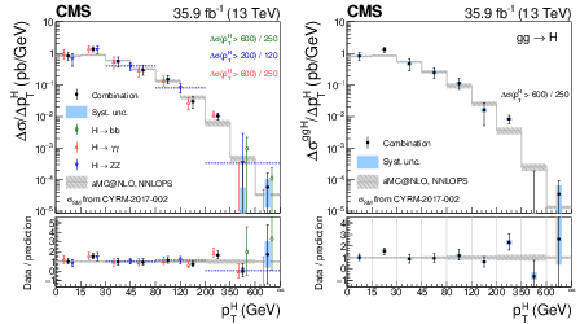
png pdf |
Figure 2:
Measurement of the total differential cross section (left) and the differential cross section of gluon fusion (right) as a function of $ {{p_{\mathrm {T}}} ^ {{\mathrm {H}}}} $. The combined spectrum is shown as black points with error bars indicating a 1 standard deviation uncertainty. The systematic component of the uncertainty is shown by a blue band. The spectra for the $ {{{\mathrm {H}}} \to {{\gamma}} {{\gamma}}} $, $ {{{\mathrm {H}}} \to {{\mathrm {Z}}} {{\mathrm {Z}}}} $, and $ {{{\mathrm {H}}} \to {{\mathrm {b}} {\overline {\mathrm {b}}}}} $ channels are shown in red, blue, and green, respectively. The dotted horizontal lines in the $ {{{\mathrm {H}}} \to {{\mathrm {Z}}} {{\mathrm {Z}}}} $ channel indicate the coarser binning of this measurement. The rightmost bins of the distributions are overflow bins; the normalizations of the cross sections in these bins are indicated in the figure. CYRM-2017-002 refers to Ref. [55]. |
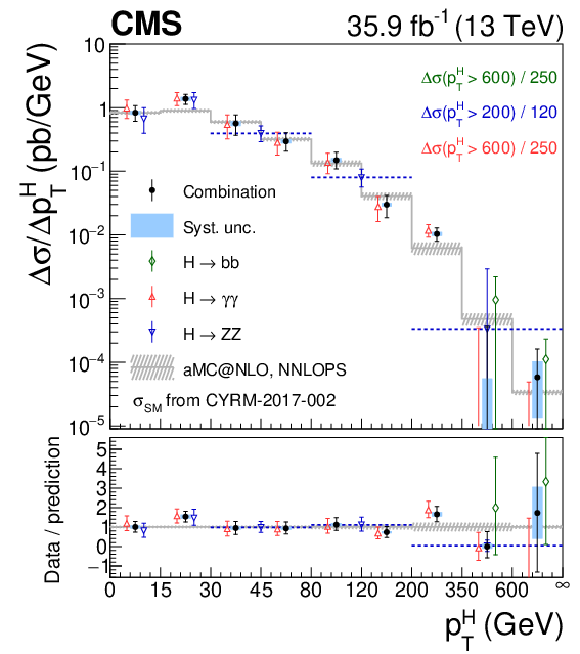
png pdf |
Figure 2-a:
Measurement of the total differential cross section as a function of $ {{p_{\mathrm {T}}} ^ {{\mathrm {H}}}} $. The combined spectrum is shown as black points with error bars indicating a 1 standard deviation uncertainty. The systematic component of the uncertainty is shown by a blue band. The spectra for the $ {{{\mathrm {H}}} \to {{\gamma}} {{\gamma}}} $, $ {{{\mathrm {H}}} \to {{\mathrm {Z}}} {{\mathrm {Z}}}} $, and $ {{{\mathrm {H}}} \to {{\mathrm {b}} {\overline {\mathrm {b}}}}} $ channels are shown in red, blue, and green, respectively. The dotted horizontal lines in the $ {{{\mathrm {H}}} \to {{\mathrm {Z}}} {{\mathrm {Z}}}} $ channel indicate the coarser binning of this measurement. The rightmost bins of the distributions are overflow bins; the normalizations of the cross sections in these bins are indicated in the figure. CYRM-2017-002 refers to Ref. [55]. |
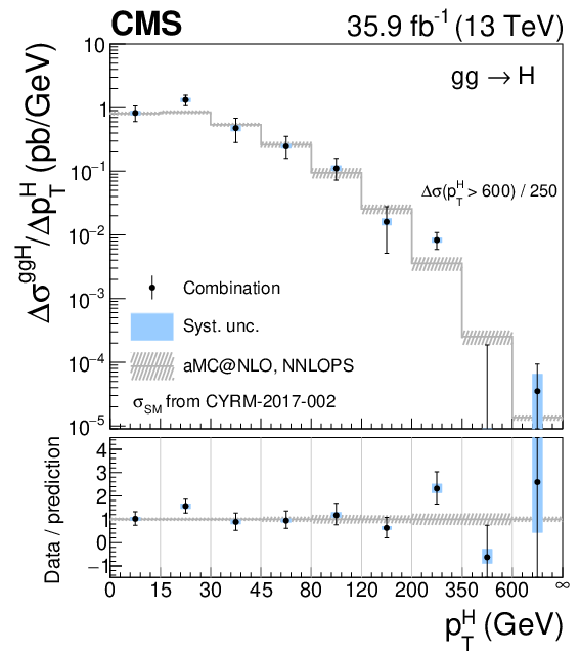
png pdf |
Figure 2-b:
Measurement of the differential cross section of gluon fusion as a function of $ {{p_{\mathrm {T}}} ^ {{\mathrm {H}}}} $. The combined spectrum is shown as black points with error bars indicating a 1 standard deviation uncertainty. The systematic component of the uncertainty is shown by a blue band. The spectra for the $ {{{\mathrm {H}}} \to {{\gamma}} {{\gamma}}} $, $ {{{\mathrm {H}}} \to {{\mathrm {Z}}} {{\mathrm {Z}}}} $, and $ {{{\mathrm {H}}} \to {{\mathrm {b}} {\overline {\mathrm {b}}}}} $ channels are shown in red, blue, and green, respectively. The dotted horizontal lines in the $ {{{\mathrm {H}}} \to {{\mathrm {Z}}} {{\mathrm {Z}}}} $ channel indicate the coarser binning of this measurement. The rightmost bins of the distributions are overflow bins; the normalizations of the cross sections in these bins are indicated in the figure. CYRM-2017-002 refers to Ref. [55]. |
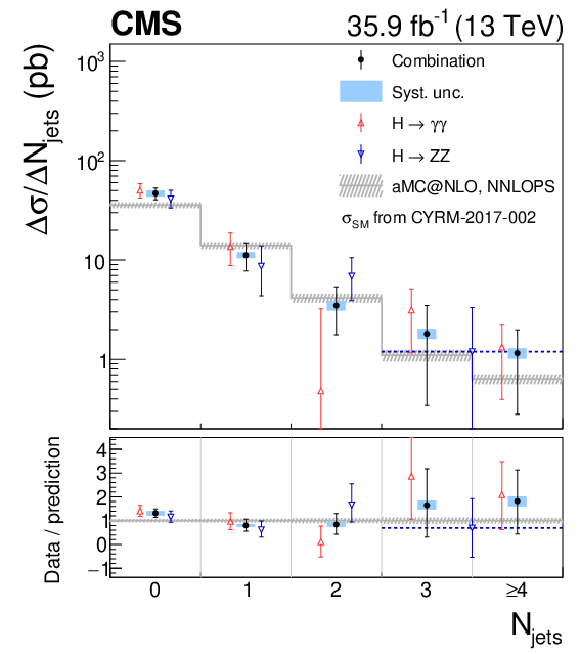
png pdf |
Figure 3:
Measurement of the differential cross section as a function of $ {N_\text {jets}} $. The combined spectrum is shown as black points with error bars indicating a 1 standard deviation uncertainty. The systematic component of the uncertainty is shown by a blue band. The spectra for the $ {{{\mathrm {H}}} \to {{\gamma}} {{\gamma}}} $ and $ {{{\mathrm {H}}} \to {{\mathrm {Z}}} {{\mathrm {Z}}}} $ channels are shown in red and blue, respectively. The dotted horizontal lines in the $ {{{\mathrm {H}}} \to {{\mathrm {Z}}} {{\mathrm {Z}}}} $ channel indicate the coarser binning of this measurement. CYRM-2017-002 refers to Ref. [55]. |
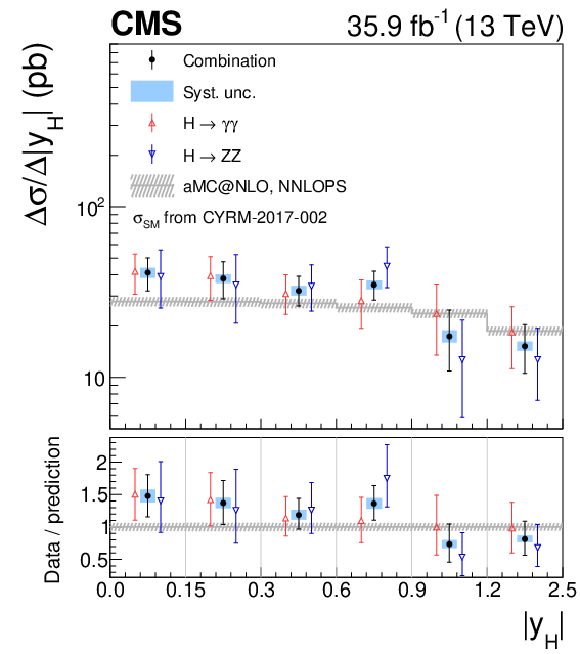
png pdf |
Figure 4:
Measurement of the differential cross section as a function of $ {{| y_ {{\mathrm {H}}} |}} $. The combined spectrum is shown as black points with error bars indicating a 1 standard deviation uncertainty. The systematic component of the uncertainty is shown by a blue band. The spectra for the $ {{{\mathrm {H}}} \to {{\gamma}} {{\gamma}}} $ and $ {{{\mathrm {H}}} \to {{\mathrm {Z}}} {{\mathrm {Z}}}} $ channels are shown in red and blue, respectively. CYRM-2017-002 refers to Ref. [55]. |
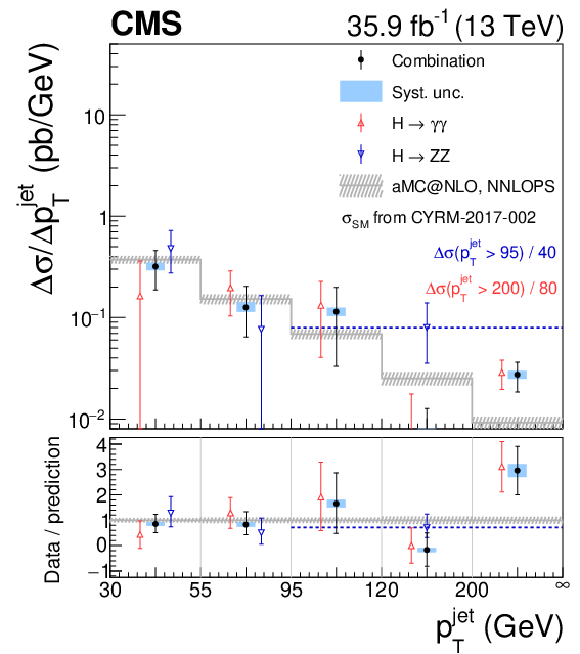
png pdf |
Figure 5:
Measurement of the differential cross section as a function of $ {{p_{\mathrm {T}}} ^\text {jet}} $. The combined spectrum is shown as black points with error bars indicating a 1 standard deviation uncertainty. The systematic component of the uncertainty is shown by a blue band. The spectra for the $ {{{\mathrm {H}}} \to {{\gamma}} {{\gamma}}} $ and $ {{{\mathrm {H}}} \to {{\mathrm {Z}}} {{\mathrm {Z}}}} $ channels are shown in red and blue, respectively. The dotted horizontal lines in the $ {{{\mathrm {H}}} \to {{\mathrm {Z}}} {{\mathrm {Z}}}} $ channel indicate the coarser binning of this measurement. The rightmost bin of the distribution is an overflow bin; the normalization of the cross section in that bin is indicated in the figure. CYRM-2017-002 refers to Ref. [55]. |
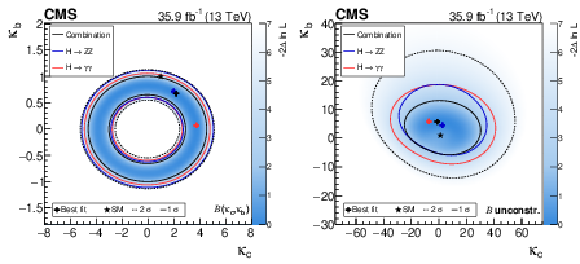
png pdf |
Figure 6:
Simultaneous fit to data for $ {\kappa _{{{\mathrm {b}}}}} $ and $ {\kappa _{{{\mathrm {c}}}}} $, assuming a coupling dependence of the branching fractions (left) and the branching fractions implemented as nuisance parameters with no prior constraint (right). The one standard deviation contour is drawn for the combination ($ {{{\mathrm {H}}} \to {{\gamma}} {{\gamma}}} $ and $ {{{\mathrm {H}}} \to {{\mathrm {Z}}} {{\mathrm {Z}}}} $), the $ {{{\mathrm {H}}} \to {{\gamma}} {{\gamma}}} $ channel, and the $ {{{\mathrm {H}}} \to {{\mathrm {Z}}} {{\mathrm {Z}}}} $ channel in black, red, and blue, respectively. For the combination the two standard deviation contour is drawn as a black dashed line, and the shading indicates the negative log-likelihood, with the scale shown on the right hand side of the plots. |
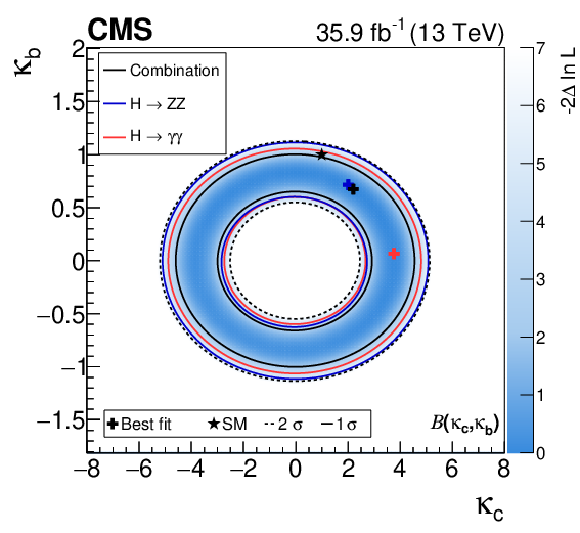
png pdf |
Figure 6-a:
Simultaneous fit to data for $ {\kappa _{{{\mathrm {b}}}}} $ and $ {\kappa _{{{\mathrm {c}}}}} $, assuming a coupling dependence of the branching fractions. The one standard deviation contour is drawn for the combination ($ {{{\mathrm {H}}} \to {{\gamma}} {{\gamma}}} $ and $ {{{\mathrm {H}}} \to {{\mathrm {Z}}} {{\mathrm {Z}}}} $), the $ {{{\mathrm {H}}} \to {{\gamma}} {{\gamma}}} $ channel, and the $ {{{\mathrm {H}}} \to {{\mathrm {Z}}} {{\mathrm {Z}}}} $ channel in black, red, and blue, respectively. For the combination the two standard deviation contour is drawn as a black dashed line, and the shading indicates the negative log-likelihood, with the scale shown on the right hand side of the plots. |
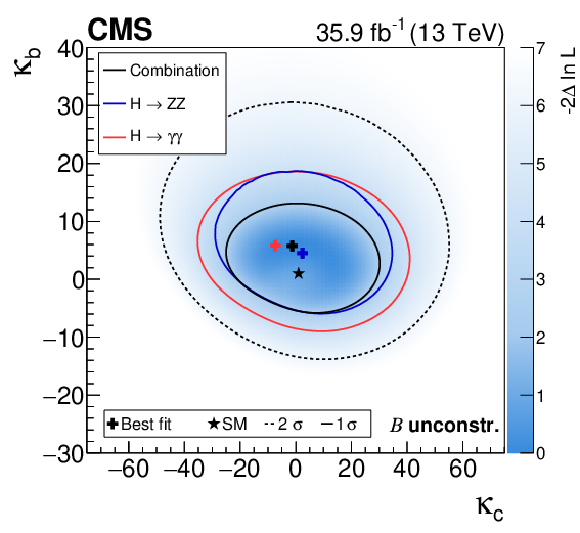
png pdf |
Figure 6-b:
Simultaneous fit to data for $ {\kappa _{{{\mathrm {b}}}}} $ and $ {\kappa _{{{\mathrm {c}}}}} $, with branching fractions implemented as nuisance parameters with no prior constraint. The one standard deviation contour is drawn for the combination ($ {{{\mathrm {H}}} \to {{\gamma}} {{\gamma}}} $ and $ {{{\mathrm {H}}} \to {{\mathrm {Z}}} {{\mathrm {Z}}}} $), the $ {{{\mathrm {H}}} \to {{\gamma}} {{\gamma}}} $ channel, and the $ {{{\mathrm {H}}} \to {{\mathrm {Z}}} {{\mathrm {Z}}}} $ channel in black, red, and blue, respectively. For the combination the two standard deviation contour is drawn as a black dashed line, and the shading indicates the negative log-likelihood, with the scale shown on the right hand side of the plots. |
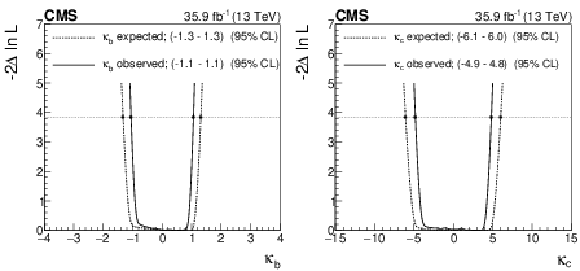
png pdf |
Figure 7:
Likelihood scan of $ {\kappa _{{{\mathrm {b}}}}} $ while profiling $ {\kappa _{{{\mathrm {c}}}}} $ (left), and of $ {\kappa _{{{\mathrm {c}}}}} $ while profiling $ {\kappa _{{{\mathrm {b}}}}} $ (right). The filled markers indicate the limits at 95% CL. The branching fractions are considered dependent on the values of the couplings. |

png pdf |
Figure 7-a:
Likelihood scan of $ {\kappa _{{{\mathrm {b}}}}} $ while profiling $ {\kappa _{{{\mathrm {c}}}}} $. The filled markers indicate the limits at 95% CL. The branching fractions are considered dependent on the values of the couplings. |

png pdf |
Figure 7-b:
Likelihood scan of $ {\kappa _{{{\mathrm {c}}}}} $ while profiling $ {\kappa _{{{\mathrm {b}}}}} $. The filled markers indicate the limits at 95% CL. The branching fractions are considered dependent on the values of the couplings. |
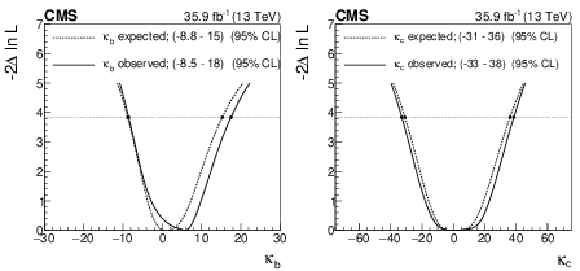
png pdf |
Figure 8:
Likelihood scan of $ {\kappa _{{{\mathrm {b}}}}} $ while profiling $ {\kappa _{{{\mathrm {c}}}}} $ (left), and of $ {\kappa _{{{\mathrm {c}}}}} $ while profiling $ {\kappa _{{{\mathrm {b}}}}} $ (right). The filled markers indicate the limits at 95% CL. The branching fractions are implemented as nuisance parameters with no prior constraint. |
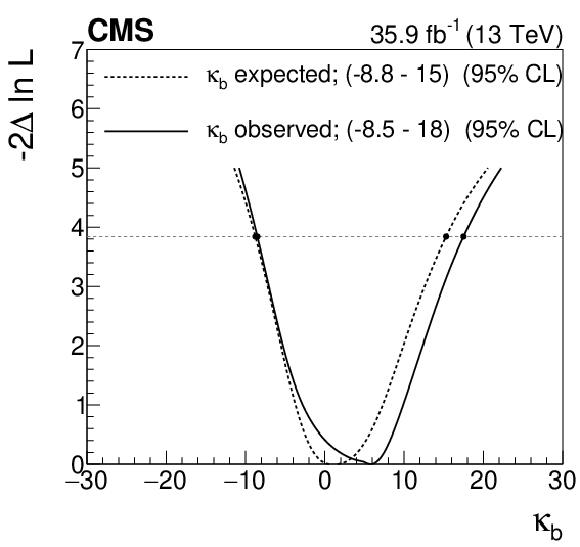
png pdf |
Figure 8-a:
Likelihood scan of $ {\kappa _{{{\mathrm {b}}}}} $ while profiling $ {\kappa _{{{\mathrm {c}}}}} $. The filled markers indicate the limits at 95% CL. The branching fractions are implemented as nuisance parameters with no prior constraint. |
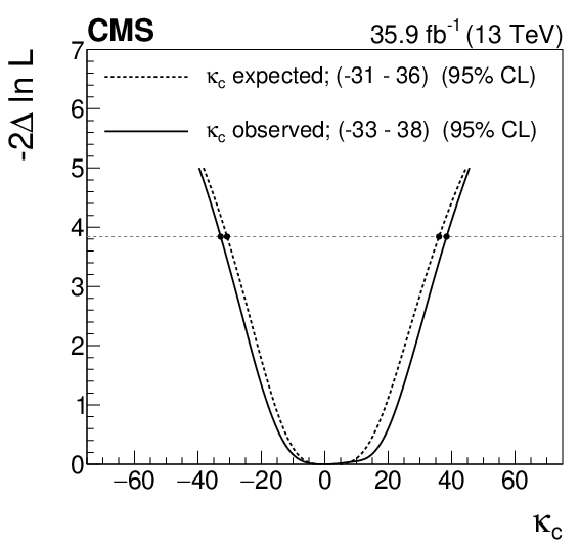
png pdf |
Figure 8-b:
Likelihood scan of $ {\kappa _{{{\mathrm {c}}}}} $ while profiling $ {\kappa _{{{\mathrm {b}}}}} $. The filled markers indicate the limits at 95% CL. The branching fractions are implemented as nuisance parameters with no prior constraint. |

png pdf |
Figure 9:
Simultaneous fit to data for $ {\kappa _{{{\mathrm {t}}}}} $ and $ {c_ {\mathrm {g}}} $, assuming a coupling dependence of the branching fractions (left) and the branching fractions implemented as nuisance parameters with no prior constraint (right). The one standard deviation contour is drawn for the combination ($ {{{\mathrm {H}}} \to {{\gamma}} {{\gamma}}} $, $ {{{\mathrm {H}}} \to {{\mathrm {Z}}} {{\mathrm {Z}}}} $, and $ {{{\mathrm {H}}} \to {{\mathrm {b}} {\overline {\mathrm {b}}}}} $), the $ {{{\mathrm {H}}} \to {{\gamma}} {{\gamma}}} $ channel, and the $ {{{\mathrm {H}}} \to {{\mathrm {Z}}} {{\mathrm {Z}}}} $ channel in black, red, and blue, respectively. For the combination the two standard deviation contour is drawn as a black dashed line, and the shading indicates the negative log-likelihood, with the scale shown on the right hand side of the plots. |
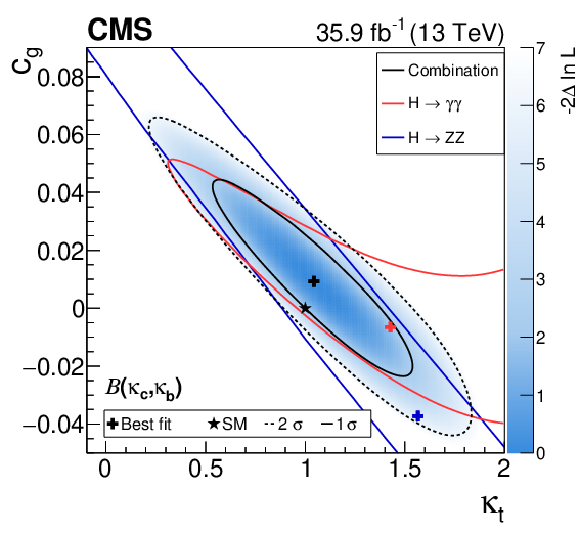
png pdf |
Figure 9-a:
Simultaneous fit to data for $ {\kappa _{{{\mathrm {t}}}}} $ and $ {c_ {\mathrm {g}}} $, assuming a coupling dependence of the branching fractions. The one standard deviation contour is drawn for the combination ($ {{{\mathrm {H}}} \to {{\gamma}} {{\gamma}}} $, $ {{{\mathrm {H}}} \to {{\mathrm {Z}}} {{\mathrm {Z}}}} $, and $ {{{\mathrm {H}}} \to {{\mathrm {b}} {\overline {\mathrm {b}}}}} $), the $ {{{\mathrm {H}}} \to {{\gamma}} {{\gamma}}} $ channel, and the $ {{{\mathrm {H}}} \to {{\mathrm {Z}}} {{\mathrm {Z}}}} $ channel in black, red, and blue, respectively. For the combination the two standard deviation contour is drawn as a black dashed line, and the shading indicates the negative log-likelihood, with the scale shown on the right hand side of the plots. |
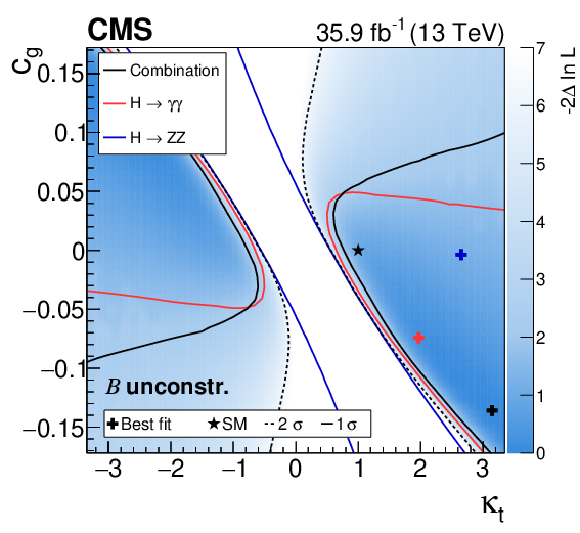
png pdf |
Figure 9-b:
Simultaneous fit to data for $ {\kappa _{{{\mathrm {t}}}}} $ and $ {c_ {\mathrm {g}}} $, with branching fractions implemented as nuisance parameters with no prior constraint. The one standard deviation contour is drawn for the combination ($ {{{\mathrm {H}}} \to {{\gamma}} {{\gamma}}} $, $ {{{\mathrm {H}}} \to {{\mathrm {Z}}} {{\mathrm {Z}}}} $, and $ {{{\mathrm {H}}} \to {{\mathrm {b}} {\overline {\mathrm {b}}}}} $), the $ {{{\mathrm {H}}} \to {{\gamma}} {{\gamma}}} $ channel, and the $ {{{\mathrm {H}}} \to {{\mathrm {Z}}} {{\mathrm {Z}}}} $ channel in black, red, and blue, respectively. For the combination the two standard deviation contour is drawn as a black dashed line, and the shading indicates the negative log-likelihood, with the scale shown on the right hand side of the plots. |
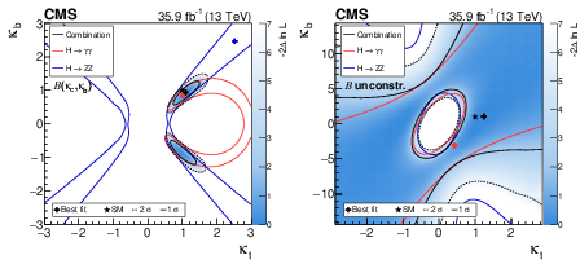
png pdf |
Figure 10:
Simultaneous fit to data for $ {\kappa _{{{\mathrm {t}}}}} $ and $ {\kappa _{{{\mathrm {b}}}}} $, assuming a coupling dependence of the branching fractions (left) and the branching fractions implemented as nuisance parameters with no prior constraint (right). The one standard deviation contour is drawn for the combination ($ {{{\mathrm {H}}} \to {{\gamma}} {{\gamma}}} $, $ {{{\mathrm {H}}} \to {{\mathrm {Z}}} {{\mathrm {Z}}}} $, and $ {{{\mathrm {H}}} \to {{\mathrm {b}} {\overline {\mathrm {b}}}}} $), the $ {{{\mathrm {H}}} \to {{\gamma}} {{\gamma}}} $ channel, and the $ {{{\mathrm {H}}} \to {{\mathrm {Z}}} {{\mathrm {Z}}}} $ channel in black, red, and blue, respectively. For the combination the two standard deviation contour is drawn as a black dashed line, and the shading indicates the negative log-likelihood, with the scale shown on the right hand side of the plots. |
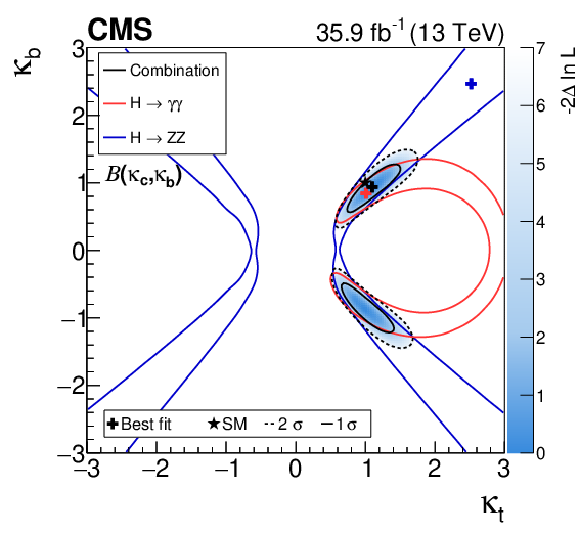
png pdf |
Figure 10-a:
Simultaneous fit to data for $ {\kappa _{{{\mathrm {t}}}}} $ and $ {\kappa _{{{\mathrm {b}}}}} $, assuming a coupling dependence of the branching fractions. The one standard deviation contour is drawn for the combination ($ {{{\mathrm {H}}} \to {{\gamma}} {{\gamma}}} $, $ {{{\mathrm {H}}} \to {{\mathrm {Z}}} {{\mathrm {Z}}}} $, and $ {{{\mathrm {H}}} \to {{\mathrm {b}} {\overline {\mathrm {b}}}}} $), the $ {{{\mathrm {H}}} \to {{\gamma}} {{\gamma}}} $ channel, and the $ {{{\mathrm {H}}} \to {{\mathrm {Z}}} {{\mathrm {Z}}}} $ channel in black, red, and blue, respectively. For the combination the two standard deviation contour is drawn as a black dashed line, and the shading indicates the negative log-likelihood, with the scale shown on the right hand side of the plots. |
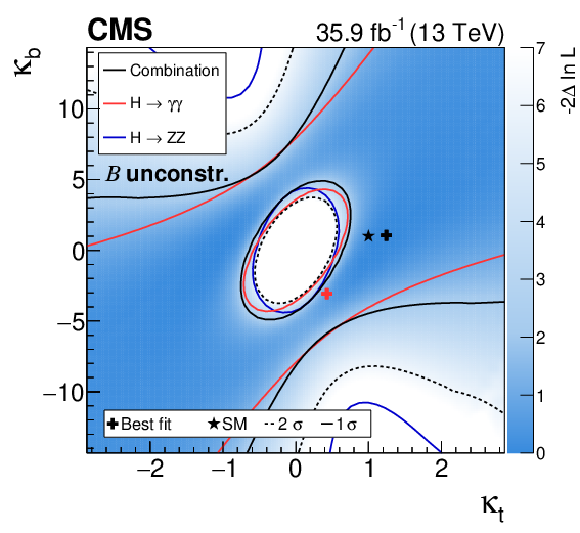
png pdf |
Figure 10-b:
Simultaneous fit to data for $ {\kappa _{{{\mathrm {t}}}}} $ and $ {\kappa _{{{\mathrm {b}}}}} $, with branching fractions implemented as nuisance parameters with no prior constraint. The one standard deviation contour is drawn for the combination ($ {{{\mathrm {H}}} \to {{\gamma}} {{\gamma}}} $, $ {{{\mathrm {H}}} \to {{\mathrm {Z}}} {{\mathrm {Z}}}} $, and $ {{{\mathrm {H}}} \to {{\mathrm {b}} {\overline {\mathrm {b}}}}} $), the $ {{{\mathrm {H}}} \to {{\gamma}} {{\gamma}}} $ channel, and the $ {{{\mathrm {H}}} \to {{\mathrm {Z}}} {{\mathrm {Z}}}} $ channel in black, red, and blue, respectively. For the combination the two standard deviation contour is drawn as a black dashed line, and the shading indicates the negative log-likelihood, with the scale shown on the right hand side of the plots. |
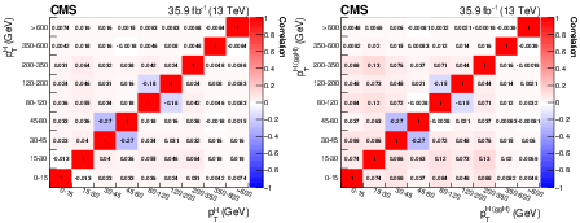
png pdf |
Figure 11:
Bin-to-bin correlation matrix of the $ {{p_{\mathrm {T}}} ^ {{\mathrm {H}}}} $ spectrum (left) and of the $ {{p_{\mathrm {T}}} ^ {{\mathrm {H}}}} $ spectrum of gluon fusion ($ {{\mathrm {g}} {\mathrm {g}} {{\mathrm {H}}}} $), where the non-$ {{\mathrm {g}} {\mathrm {g}} {{\mathrm {H}}}}$ contributions are fixed to the SM expectation (right). |

png pdf |
Figure 11-a:
Bin-to-bin correlation matrix of the $ {{p_{\mathrm {T}}} ^ {{\mathrm {H}}}} $ spectrum. |
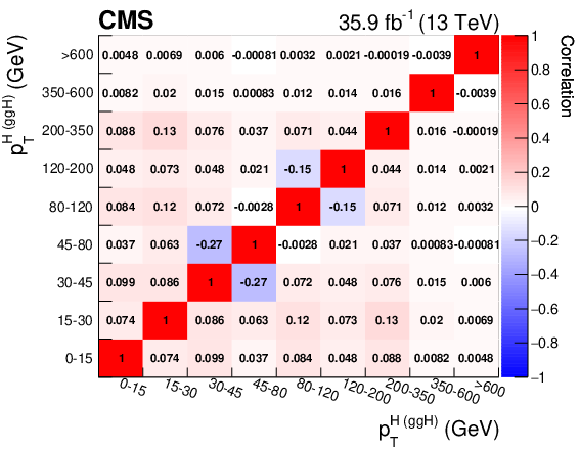
png pdf |
Figure 11-b:
The $ {{p_{\mathrm {T}}} ^ {{\mathrm {H}}}} $ spectrum of gluon fusion ($ {{\mathrm {g}} {\mathrm {g}} {{\mathrm {H}}}} $), where the non-$ {{\mathrm {g}} {\mathrm {g}} {{\mathrm {H}}}}$ contributions are fixed to the SM expectation. |
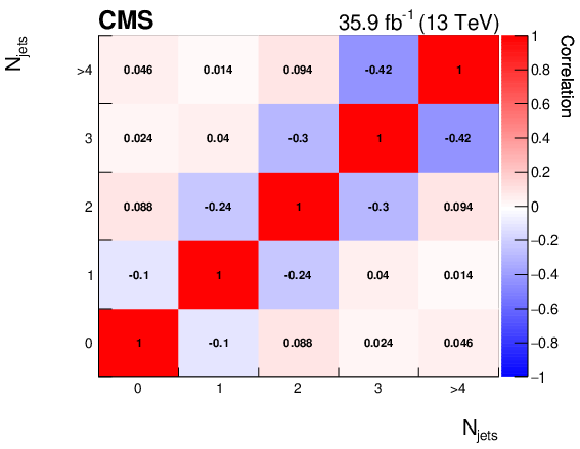
png pdf |
Figure 12:
Bin-to-bin correlation matrix of the $ {N_\text {jets}} $ spectrum. |

png pdf |
Figure 13:
Bin-to-bin correlation matrix of the $ {{| y_ {{\mathrm {H}}} |}} $ spectrum. |

png pdf |
Figure 14:
Bin-to-bin correlation matrix of the $ {{p_{\mathrm {T}}} ^\text {jet}} $ spectrum. |
| Tables | |

png pdf |
Table 1:
The reconstruction-level binning for $ {{p_{\mathrm {T}}} ^ {{\mathrm {H}}}} $ for the $ {{{\mathrm {H}}} \to {{\gamma}} {{\gamma}}} $, $ {{{\mathrm {H}}} \to {{\mathrm {Z}}} {{\mathrm {Z}}}} $, and $ {{{\mathrm {H}}} \to {{\mathrm {b}} {\overline {\mathrm {b}}}}} $ channels. This binning coincides with the binning of the unfolded cross sections in which the individual results are reported. |

png pdf |
Table 2:
The binning for $ {N_\text {jets}} $ for the $ {{{\mathrm {H}}} \to {{\gamma}} {{\gamma}}} $ and the $ {{{\mathrm {H}}} \to {{\mathrm {Z}}} {{\mathrm {Z}}}} $ channels. This binning coincides with the binning of the unfolded cross sections in which the individual results are reported. |

png pdf |
Table 3:
The binning for $ {{| y_ {{\mathrm {H}}} |}} $ for the $ {{{\mathrm {H}}} \to {{\gamma}} {{\gamma}}} $ and the $ {{{\mathrm {H}}} \to {{\mathrm {Z}}} {{\mathrm {Z}}}} $ channels. This binning coincides with the binning of the unfolded cross sections in which the individual results are reported. |

png pdf |
Table 4:
The binning for $ {{p_{\mathrm {T}}} ^\text {jet}} $ for the $ {{{\mathrm {H}}} \to {{\gamma}} {{\gamma}}} $ and the $ {{{\mathrm {H}}} \to {{\mathrm {Z}}} {{\mathrm {Z}}}} $ channels. This binning coincides with the binning of the unfolded cross sections in which the individual results are reported. |

png pdf |
Table 5:
Uncertainties in the predicted $ {{p_{\mathrm {T}}} ^ {{\mathrm {H}}}} $ spectra related to variations of theory parameters for the $ {\kappa _{{{\mathrm {b}}}}} $ and $ {\kappa _{{{\mathrm {c}}}}} $ case. |

png pdf |
Table 6:
Uncertainties in the predicted $ {{p_{\mathrm {T}}} ^ {{\mathrm {H}}}} $ spectra related to variations of theory parameters for the $ {\kappa _{{{\mathrm {t}}}}} $, $ {c_ {\mathrm {g}}} $, and $ {\kappa _{{{\mathrm {b}}}}} $ case. |

png pdf |
Table 7:
Differential cross sections (pb/GeV) for the observable $ {{p_{\mathrm {T}}} ^ {{\mathrm {H}}}} $. |

png pdf |
Table 8:
Differential cross sections of gluon fusion ($ {{\mathrm {g}} {\mathrm {g}} {{\mathrm {H}}}} $) (pb/GeV) for the observable $ {{p_{\mathrm {T}}} ^ {{\mathrm {H}}}} $, with non-$ {{\mathrm {g}} {\mathrm {g}} {{\mathrm {H}}}}$ production modes fixed to their SM prediction. |

png pdf |
Table 9:
Differential cross sections (pb) for the observable $ {N_\text {jets}} $. |

png pdf |
Table 10:
Differential cross sections (pb) for the observable $ {{| y_ {{\mathrm {H}}} |}} $. |

png pdf |
Table 11:
Differential cross sections (pb/GeV) for the observable $ {{p_{\mathrm {T}}} ^\text {jet}} $. |
| Summary |
|
A combination of differential cross sections for the Higgs boson transverse momentum $p_{\mathrm{T}}^{\mathrm{H}}$, the number of jets, the rapidity of the Higgs boson, and the ${p_{\mathrm{T}}}$ of the leading jet has been presented, using proton-proton collision data collected at $\sqrt{s}=$ 13 TeV with the CMS detector, corresponding to an integrated luminosity of 35.9 fb$^{-1}$. The spectra obtained are based on data from the ${{\mathrm{H}} \to{\gamma} {\gamma} } $, $\mathrm{H}\to\mathrm{Z}\mathrm{Z}$, and ${{\mathrm{H}} \to\mathrm{b\bar{b}}} $ decay channels. The precision of the combined measurement of the differential cross section of $p_{\mathrm{T}}^{\mathrm{H}}$ is improved by about 15% with respect to the ${{\mathrm{H}} \to{\gamma} {\gamma} } $ channel alone. The improvement is larger in the low-$p_{\mathrm{T}}^{\mathrm{H}}$ region than in the high-$p_{\mathrm{T}}^{\mathrm{H}}$ tails. No significant deviations from the standard model are observed in any differential distribution. Additionally, the total cross section for Higgs boson production based on a combination of the ${{\mathrm{H}} \to{\gamma} {\gamma} } $ and $\mathrm{H}\to\mathrm{Z}\mathrm{Z}$ channels is measured to be 61.1 $\pm$ 6.0 (stat) $\pm$ 3.7 (syst) pb. The spectra obtained are interpreted in the $\kappa$-framework [30], in which simultaneous variations of ${\kappa_{{\mathrm{b}} }} $ and ${\kappa_{{\mathrm{c}} }} $, ${\kappa_{{\mathrm{t}} }} $ and ${\kappa_{{\mathrm{b}} }} $, and ${\kappa_{{\mathrm{t}} }} $ and the anomalous direct coupling to the gluon field ${c_\mathrm{g}} $ are fitted to the $p_{\mathrm{T}}^{\mathrm{H}}$ spectra. The limits obtained for the individual couplings are $-1.1 < {\kappa_{{\mathrm{b}} }} < 1.1$ and $-4.9 < {\kappa_{{\mathrm{c}} }} < 4.8$ at 95% confidence level, assuming the branching fractions scale with the Higgs boson couplings following the standard model prediction. For the charm coupling ${\kappa_{{\mathrm{c}} }} $ in particular, these bounds are comparable with those obtained from direct searches with charm quarks in the final state. |
| References | ||||
| 1 | P. W. Higgs | Broken symmetries and the masses of gauge bosons | PRL 13 (1964) 508 | |
| 2 | F. Englert and R. Brout | Broken symmetry and the mass of gauge vector mesons | PRL 13 (1964) 321 | |
| 3 | G. S. Guralnik, C. R. Hagen, and T. W. B. Kibble | Global conservation laws and massless particles | PRL 13 (1964) 585 | |
| 4 | ATLAS Collaboration | Observation of a new particle in the search for the standard model Higgs boson with the ATLAS detector at the LHC | PLB 716 (2012) 1 | 1207.7214 |
| 5 | CMS Collaboration | Observation of a new boson at a mass of 125 GeV with the CMS experiment at the LHC | PLB 716 (2012) 30 | CMS-HIG-12-028 1207.7235 |
| 6 | CMS Collaboration | Observation of a new boson with mass near 125 GeV in pp collisions at $ \sqrt{s} = $ 7 and 8 TeV | JHEP 06 (2013) 081 | CMS-HIG-12-036 1303.4571 |
| 7 | ATLAS and CMS Collaborations | Measurements of the Higgs boson production and decay rates and constraints on its couplings from a combined ATLAS and CMS analysis of the LHC pp collision data at $ \sqrt{s} = $ 7 and 8 TeV | JHEP 08 (2016) 045 | 1606.02266 |
| 8 | ATLAS and CMS Collaborations | Combined measurement of the Higgs boson mass in pp collisions at $ \sqrt{s} = $ 7 and 8 TeV with the ATLAS and CMS experiments | PRL 114 (2015) 191803 | 1503.07589 |
| 9 | CMS Collaboration | Combined measurements of Higgs boson couplings in proton-proton collisions at $ \sqrt{s}= $ 13 TeV | Submitted to EPJC | CMS-HIG-17-031 1809.10733 |
| 10 | S. Dimopoulos and H. Georgi | Softly broken supersymmetry and SU(5) | NPB 193 (1981) 150 | |
| 11 | E. Witten | Dynamical breaking of supersymmetry | NPB 188 (1981) 513 | |
| 12 | F. Bishara, U. Haisch, P. F. Monni, and E. Re | Constraining light-quark Yukawa couplings from Higgs distributions | PRL 118 (2017) 121801 | 1606.09253 |
| 13 | ATLAS Collaboration | Search for Higgs and Z boson decays to J/$ \psi\gamma $ and $ \Upsilon(nS)\gamma $ with the ATLAS detector | PRL 114 (2015) 121801 | 1501.03276 |
| 14 | M. Konig and M. Neubert | Exclusive radiative Higgs decays as probes of light-quark Yukawa couplings | JHEP 08 (2015) 012 | 1505.03870 |
| 15 | ATLAS Collaboration | Search for the decay of the Higgs boson to charm quarks with the ATLAS experiment | PRL 120 (2018) 211802 | 1802.04329 |
| 16 | ATLAS Collaboration | Measurements of fiducial and differential cross sections for Higgs boson production in the diphoton decay channel at $ \sqrt{s} = $ 8 TeV with ATLAS | JHEP 09 (2014) 112 | 1407.4222 |
| 17 | CMS Collaboration | Measurement of differential cross sections for Higgs boson production in the diphoton decay channel in pp collisions at $ \sqrt{s} = $ 8 TeV | EPJC 76 (2016) 13 | CMS-HIG-14-016 1508.07819 |
| 18 | ATLAS Collaboration | Fiducial and differential cross sections of Higgs boson production measured in the four-lepton decay channel in pp collisions at $ \sqrt{s} = $ 8 TeV with the ATLAS detector | PLB 738 (2014) 234 | 1408.3226 |
| 19 | CMS Collaboration | Measurement of differential and integrated fiducial cross sections for Higgs boson production in the four-lepton decay channel in pp collisions at $ \sqrt{s} = $ 7 and 8 TeV | JHEP 04 (2016) 005 | CMS-HIG-14-028 1512.08377 |
| 20 | ATLAS Collaboration | Measurement of fiducial differential cross sections of gluon-fusion production of Higgs bosons decaying to $ \mathrm{WW}^{*} \rightarrow e\nu\mu\nu $ with the ATLAS detector at $ \sqrt{s} = $ 8 TeV | JHEP 08 (2016) 104 | 1604.02997 |
| 21 | CMS Collaboration | Measurement of the transverse momentum spectrum of the Higgs boson produced in pp collisions at $ \sqrt{s} = $ 8 TeV using $ \mathrm{H} \to \mathrm{WW} $ decays | JHEP 03 (2017) 032 | CMS-HIG-15-010 1606.01522 |
| 22 | ATLAS Collaboration | Measurements of Higgs boson properties in the diphoton decay channel with 36 $ \text{fb}^{-1} $ of pp collision data at $ \sqrt{s} = $ 13 TeV with the ATLAS detector | Submitted to PRD | 1802.04146 |
| 23 | CMS Collaboration | Measurement of inclusive and differential Higgs boson production cross sections in the diphoton decay channel in proton-proton collisions at $ \sqrt{s}= $ 13 TeV | Submitted to JHEP | CMS-HIG-17-025 1807.03825 |
| 24 | ATLAS Collaboration | Measurement of inclusive and differential cross sections in the $ \mathrm{H} \rightarrow \mathrm{ZZ}^* \rightarrow 4\ell $ decay channel in pp collisions at $ \sqrt{s} = $ 13 TeV with the ATLAS detector | JHEP 10 (2017) 132 | 1708.02810 |
| 25 | CMS Collaboration | Measurements of properties of the Higgs boson decaying into the four-lepton final state in pp collisions at $ \sqrt{s} = $ 13 TeV | JHEP 11 (2017) 047 | CMS-HIG-16-041 1706.09936 |
| 26 | ATLAS Collaboration | Combined measurement of differential and total cross sections in the $ \mathrm{H} \rightarrow \gamma \gamma $ and the $ \mathrm{H} \rightarrow \mathrm{ZZ}^* \rightarrow 4\ell $ decay channels at $ \sqrt{s} = $ 13 TeV with the ATLAS detector | Submitted to PLB | 1805.10197 |
| 27 | CMS Collaboration | Inclusive search for a highly boosted Higgs boson decaying to a bottom quark-antiquark pair | PRL 120 (2018) 071802 | CMS-HIG-17-010 1709.05543 |
| 28 | M. Grazzini, A. Ilnicka, M. Spira, and M. Wiesemann | Effective field theory for Higgs properties parametrisation: The transverse momentum spectrum case | in Proceedings, 52nd Rencontres de Moriond on QCD and High Energy Interactions: La Thuile, Italy, March 25-April 1, 2017, p. 23 2017 | 1705.05143 |
| 29 | M. Grazzini, A. Ilnicka, M. Spira, and M. Wiesemann | Modeling BSM effects on the Higgs transverse-momentum spectrum in an EFT approach | JHEP 03 (2017) 115 | 1612.00283 |
| 30 | LHC Higgs Cross Section Working Group | Handbook of LHC Higgs cross sections: 3. Higgs properties | CERN (2013) | 1307.1347 |
| 31 | A. Banfi, P. F. Monni, and G. Zanderighi | Quark masses in Higgs production with a jet veto | JHEP 01 (2014) 097 | 1308.4634 |
| 32 | G. Bozzi, S. Catani, D. de Florian, and M. Grazzini | The $ q_\text{T} $ spectrum of the Higgs boson at the LHC in QCD perturbation theory | PLB 564 (2003) 65 | hep-ph/0302104 |
| 33 | T. Becher and M. Neubert | Drell-Yan production at small $ q_\text{T} $, transverse parton distributions and the collinear anomaly | EPJC 71 (2011) 1665 | 1007.4005 |
| 34 | P. F. Monni, E. Re, and P. Torrielli | Higgs transverse-momentum resummation in direct space | PRL 116 (2016) 242001 | 1604.02191 |
| 35 | CMS Collaboration | The CMS experiment at the CERN LHC | JINST 3 (2008) S08004 | CMS-00-001 |
| 36 | J. Alwall et al. | The automated computation of tree-level and next-to-leading order differential cross sections, and their matching to parton shower simulations | JHEP 07 (2014) 079 | 1405.0301 |
| 37 | T. Sjostrand et al. | An introduction to PYTHIA 8.2 | CPC 191 (2015) 159 | 1410.3012 |
| 38 | P. Skands, S. Carrazza, and J. Rojo | Tuning PYTHIA 8.1: the Monash 2013 tune | EPJC 74 (2014) 3024 | 1404.5630 |
| 39 | R. Frederix and S. Frixione | Merging meets matching in MC@NLO | JHEP 12 (2012) 061 | 1209.6215 |
| 40 | K. Hamilton, P. Nason, and G. Zanderighi | MINLO: Multi-scale improved NLO | JHEP 10 (2012) 155 | 1206.3572 |
| 41 | A. Kardos, P. Nason, and C. Oleari | Three-jet production in POWHEG | JHEP 04 (2014) 043 | 1402.4001 |
| 42 | NNPDF Collaboration | Parton distributions for the LHC Run II | JHEP 04 (2015) 040 | 1410.8849 |
| 43 | CMS Collaboration | Particle-flow reconstruction and global event description with the CMS detector | JINST 12 (2017) P10003 | CMS-PRF-14-001 1706.04965 |
| 44 | M. Cacciari, G. P. Salam, and G. Soyez | The anti-$ {k_{\mathrm{T}}} $ jet clustering algorithm | JHEP 04 (2008) 063 | 0802.1189 |
| 45 | M. Dasgupta, A. Fregoso, S. Marzani, and G. P. Salam | Towards an understanding of jet substructure | JHEP 09 (2013) 029 | 1307.0007 |
| 46 | A. J. Larkoski, S. Marzani, G. Soyez, and J. Thaler | Soft drop | JHEP 05 (2014) 146 | 1402.2657 |
| 47 | J. Dolen et al. | Thinking outside the ROCs: Designing decorrelated taggers (DDT) for jet substructure | JHEP 05 (2016) 156 | 1603.00027 |
| 48 | I. Moult, L. Necib, and J. Thaler | New angles on energy correlation functions | JHEP 12 (2016) 153 | 1609.07483 |
| 49 | A. J. Larkoski, G. P. Salam, and J. Thaler | Energy correlation functions for jet substructure | JHEP 06 (2013) 108 | 1305.0007 |
| 50 | J. Thaler and K. Van Tilburg | Identifying boosted objects with N-subjettiness | JHEP 03 (2011) 015 | 1011.2268 |
| 51 | CMS Collaboration | Identification of heavy-flavour jets with the CMS detector in pp collisions at 13 TeV | JINST 13 (2018) P05011 | CMS-BTV-16-002 1712.07158 |
| 52 | P. C. Hansen | The L-curve and its use in the numerical treatment of inverse problems | in Computational Inverse Problems in Electrocardiology, p. 119 Southampton: WIT Press | |
| 53 | G. Cowan, K. Cranmer, E. Gross, and O. Vitells | Asymptotic formulae for likelihood-based tests of new physics | EPJC 71 (2011) 1554 | 1007.1727 |
| 54 | The ATLAS Collaboration, The CMS Collaboration, The LHC Higgs Combination Group | Procedure for the LHC Higgs boson search combination in Summer 2011 | CMS-NOTE-2011-005 | |
| 55 | LHC Higgs Cross Section Working Group | Handbook of LHC Higgs cross sections: 4. Deciphering the nature of the Higgs sector | CERN (2016) | 1610.07922 |

|
Compact Muon Solenoid LHC, CERN |

|

|

|

|

|

|